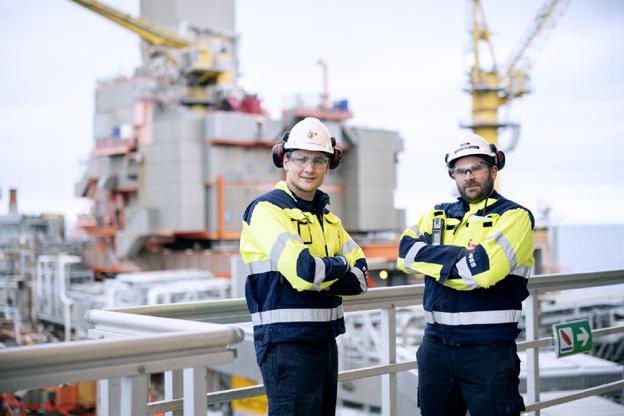
Aker BP ASA is a company engaged in exploration, field development and production of oil and gas on the Norwegian continental shelf (NCS). The company has its headquarters at Fornebu, outside Oslo, Norway as well as offices in Harstad, Trondheim, Sandnessjøen and Stavanger.
Aker BP is listed on the Oslo stock exchange (AKRBP), and major shareholders are Aker ASA (21 percent), BP PLC (16 percent) and Nemesia S.A.R.L (14 percent).
Aker BP had approximately 2,700 employees and a portfolio of 179 (182) licences, with 126 (126) as the operator and 53 (56) as a partner as of 31 December 2023.
Overview of Operations
With a total production of ~457 mboepd in 2023, Aker BP is one of the largest independent listed oil and gas companies in Europe. The company operates the field centres Alvheim, Edvard Grieg, Ivar Aasen, Skarv, Ula and Valhall, and is a partner in the Johan Sverdrup field.
In 2023, Aker BP marked its first full year as an integrated team following the acquisition of Lundin, successfully achieving all operational and financial targets. Notably, new capacity was brought on stream at Johan Sverdrup, resulting in record-high production and achieving a record-low operational cost per unit. Simultaneously, the company further reduced its greenhouse gas emission intensity from an already industry-leading level.
The field development projects progressed as planned, representing the central pillar in the company’s plan to lift production to around 525,000 barrels per day by 2028. Noteworthy exploration results included the Frigg East discovery in the Yggdrasil area.
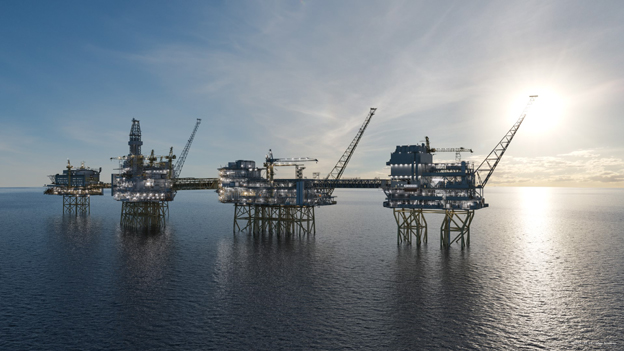
Johan Sverdrup
Equinor Energy AS: 42.63% (operator)
Aker BP ASA: 31.57%
Petoro AS: 17.36%
Total E&P Norge AS: 8.44%
Johan Sverdrup is the third largest oil field on the Norwegian shelf, with expected resources of 2.7 billion barrels of oil equivalents. This giant oil field makes a significant contribution to Aker BP’s production.
The entire field is now on stream, and accounts for roughly a third of Norway’s oil production. It also has some of the lowest CO2 emissions of any oil field in the world.
Johan Sverdrup has reserves of 2.7 billion barrels of oil equivalents, and the entire field is now in production. Phase One of Johan Sverdrup opened in October 2019, and Phase Two came on stream in December 2022.
The field is located in the Utsira High area in the North Sea, 160 kilometres west of Stavanger, in water depths of 110-120 meters, and covers an area of 200 square kilometres. The field can produce up to 755,000 barrels of oil per day at plateau, roughly a third of Norwegian oil production at current levels.
The field is estimated to generate more than 3,400 person-years of work each year, and production from the field has already contributed substantially to the Norwegian welfare state. Eighty-two percent of revenues from Johan Sverdrup go to the state through taxes and direct ownership interest, estimated at a total of about NOK 900 billion over the lifespan of the field.
Johan Sverdrup has some of the lowest CO2 emissions of any oil field in the world, 80-90% lower than the global average, thanks to electrification with power from shore.
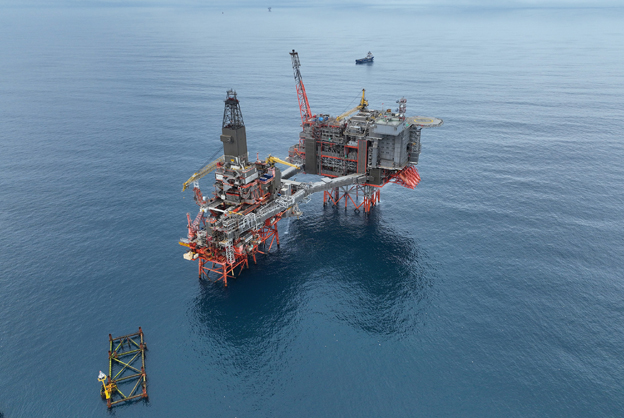
Valhall
Aker BP ASA: 90% (operator)
Pandion Energy AS: 10%
The giant Valhall has produced over a billion barrels of oil equivalents since the field was opened in 1982. The ambition is to produce another billion barrels over the next 40 years.
The Valhall field is located in the southern part of the Norwegian sector in the North Sea, and although the field has been in production for several decades, Aker BP sees enormous potential in the area. The work of modernizing Valhall is well underway, and involves removing old platforms, plugging old wells, investing in new wells and actively seeking new business opportunities in the area.
Since 2013, the Valhall field has been operated with electricity from shore.
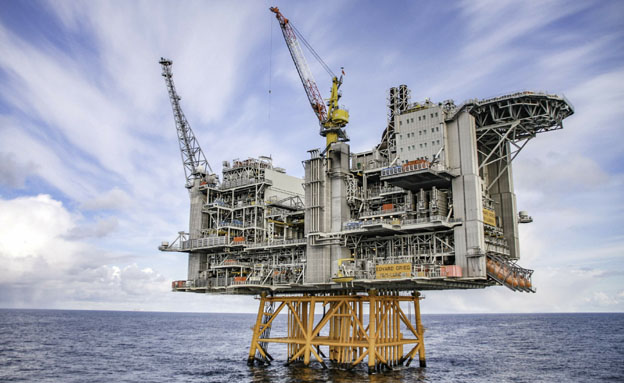
Edvard Grieg
OMV AS: 20%
Harbour Energy: 15%
Aker BP ASA: 65% (operator)
The first oil and gas was produced from the Edvard Grieg field in November 2015. Since then, the platform and operations personnel on board have ensured very high operational regularity and high production.
The total P2 reserves for Edvard Grieg are currently estimated at 379 million barrels of oil equivalent, compared with the 186 million estimated when the plan for development and operation (PDO) was approved. In simple terms, the increases are due to two factors. The reservoir on Edvard Grieg has proven to contain more oil than we initially presumed, and the understanding of the reservoir has continued to improve. Technology such as 4D seismic has allowed the Edvard Grieg team to continually update the reservoir model and drainage strategy.
Edvard Grieg is located about 10 kilometres from the Ivar Aasen field and receives oil and gas from Ivar Aasen for final processing and export.
As early as the drawing board stage, Edvard Grieg was planned as a field centre with the capacity to be a host platform for new fields in the vicinity. Today Edvard Grieg is host platform for the Solveig field. Phase 2 of the Solveig development is currently in the construction phase. That is also the case for the Troldhaugen and Symra developments. Troldhaugen will be a tie-in to Edvard Grieg while Symra will be tied back to Ivar Aasen. Oil and gas is transported from Ivar Aasen to Edvard Grieg for final processing.
Edvard Grieg receives power from shore through the area solution for the Utsira High. Hence, Edvard Grieg is producing with very low CO2 emissions.
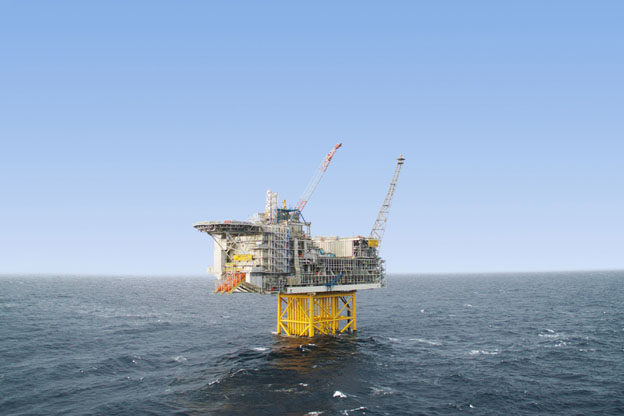
Ivar Aasen
Aker BP ASA: 36.17% (operator)
Equinor Energy AS: 41.47%
Sval Energi AS: 12.32%
OKEA ASA: 9.24%
M Vest Energy: 0.8%
Ivar Aasen is Aker BP’s digital pilot, where new technology is applied to create the digital oil field of the future. Ivar Aasen was the first field on the Norwegian shelf to operate a manned platform from an onshore control room. The result is increased recovery and high production efficiency.
The Ivar Aasen field is located at the Utsira Height in the northern part of the North Sea, around 175 km west of Karmøy. The field was discovered in 2008 and was linked to previous discoveries in the immediate area. The plan for development and operation was approved in May 2013.
The first oil was produced on December 24, 2016.
Digital pilot
Ivar Aasen is Aker BPs digital pilot, where new technology is applied and tested. The platform has a digital twin based on real-time data from Cognite. The technology helps reduce costs through performance analysis and optimization in the virtual environment.
Ivar Aasen was the first field where Aker BP equipped all operators on the platform with handheld digital devices. This provides paperless access to technical documentation and real-time information on equipment. The handheld devices contribute to more efficient and safe operation.
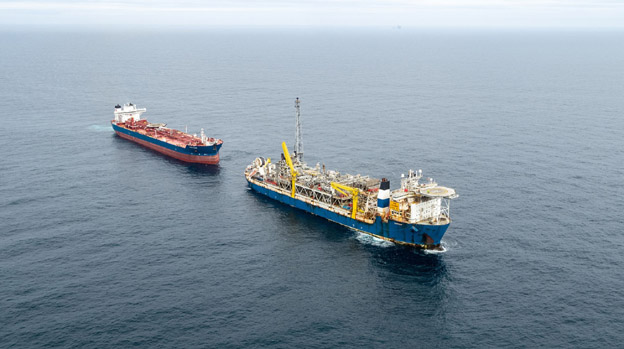
Alvheim
Aker BP ASA: 80% (operator)
ConocoPhillips Skandinavia AS: 20%
Aker BP’s ambition is to produce one billion barrels through the Alvheim FPSO. New wells and tie-in of other fields in the area are important steps towards achieving the goal.
Alvheim is located in the central part of the North Sea, close to the British sector. The field has larger recoverable oil and gas resources than originally estimated, and production has been better than expected. The Alvheim area also consists of the Boa, Vilje, Volund, Bøyla and Skogul fields, which are produced via Alvheim FPSO.
Increased oil recovery is an important part of the strategy for the Alvheim area and to extend the lifetime of the field center. Debottlenecking to improve capacity on the FPSO is underway to facilitate tie-in of more discoveries in the years to come.
Maturing discoveries
The Skogul field was tied-in to Alvheim and started production in 2020, while Frosk started production in 2023. Aker BP continues to mature the discoveries Kobra East & Gekko (KEG), and Tyrving, all of which are located in the Alvheim area. The goal is to put these into production in the coming years.
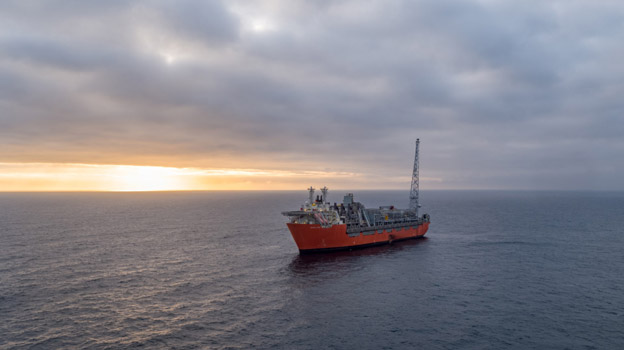
Skarv
Aker BP ASA: 23.84% (operator)
Equinor Energy AS: 36.17%
Harbour Energy: 28.08%
PGNiG Upstream Norway AS: 11.92%
Skarv is a field in the northern part of the Norwegian Sea. The field has been developed with a floating production, storage and offloading vessel (FPSO) and has one of the world’s largest offshore gas processing plants on this type of facility. The ambition for the Skarv area estend to 2040 and beyond.
Skarv was discovered in 1998, and the plan for development and operation (PDO) was approved in 2007. Production start-up occured on New Year’s Eve in 2012. Several deposits and fields are connected to the Skarv FPSO, including Skarv, Idun, Ærfugl and Gråsel.
The start-up for Ærfugl phase 1 in 2020 and phase 2 in 2021 contributed significantly to the increase of production from Skarv to over 170 thousand barrels per day. In addition, production from Ærfugl contributed to reducing CO2-emissions per barrel produced from Skarv FPSO by ca 30 per cent from 2022, and extended the lifetime of Skarv.
Skarv Sattelite Project (SSP)
In December 2022, Aker BP (operator) and partners submitted plans for development and operations for three separate developments in the Skarv area to the Ministry of Petroleum and Energy.
The development projects, coordinated by the Skarv Satellite Project (SSP), consist of the gas and condensate discoveries Alve Nord, Idun Nord and Ørn. Each of the developments comprises of a 4-slot template and two wells, subsea tied back to the Skarv FPSO,
The Skarv Satellites Project enables future growth by strengthening current infrastructure, increases the flexibility and prolongs estimated production period for Skarv FPSO.
Aker BP and partners are also actively exploring in the Skarv area with the aim of making new discoveries that can be developed and linked to the FPSO in the years ahead.
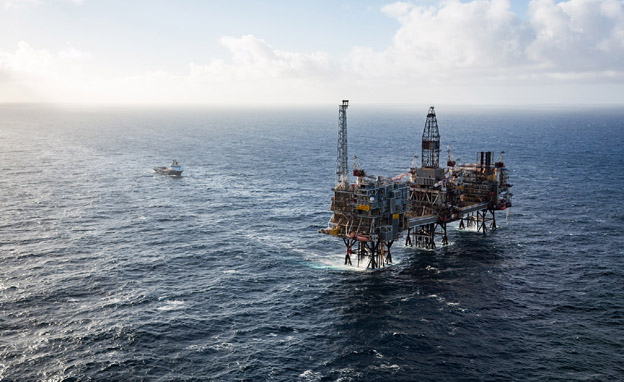
Ula
Aker BP ASA: 80%
DNO Norge AS: 20%
The Ula field started production in 1986 and is now in a late-life phase. Aker BP intend to produce from Ula until 2028 at the latest. Ula is a production hub for the fields Tambar, Oda and Blane.
The Ula field is located in the southern part of the North Sea and consists of three platforms. The field centre also processes for the Tambar, Blane and Oda fields. The Tambar/Tambar East satellite fields have a wellhead platform that is remotely controlled from Ula. Oda and Blane are developed with underwater structures.
Increased oil recovery with WAG
Oil was originally recovered by pressure depletion, but after some years, water injection was used to increase recovery. Water-alternating gas injection (WAG) started in 1998. The WAG program has been extended with gas from Tambar since 2001, Blane since 2007 and Oda from 2019. Gas lift is used in some of the wells.
The positive effect of WAG resulted in drilling of additional WAG wells. Production from Oda, which is tied-in with Ula, started in March 2019. Gas from Oda is injected into the Ula reservoir to increase production.
Field cessation and removal
Aker BP intend to produce from Ula until latest 2028, when the field’s production license expires.
Planning for field cessation has been initiated, and the environmental impact assessment will be started in 2023. Removal of the installations at the Ula field is expected in the years following 2028.
Projects
Aker BP has a large project portfolio with total net resources of around 700 million barrels of oil equivalent, which will contribute to increase their production in the years to come.
The Yggdrasil area
Yggdrasil is located between Alvheim and Oseberg in the North Sea. The area holds several oil and gas fields with gross recoverable resources estimated at around 650 million barrels of oil equivalents, with further exploration and appraisal potential.
Yggdrasil is the biggest ongoing development on the Norwegian Continental Shelf, and through it, a mature area in the North Sea is opened. The area consists of the Hugin, Fulla and Munin licence groups. Aker BP is operator with Equinor and Orlen Upstream Norway as licence partners.
The development concept
Extensive new infrastructure is planned for the area. The concept consists of a processing platform with well area and living quarters (Hugin A) that will function as an area hub. Hugin A is planned with low manning levels and is also being developed to be periodically unmanned after a few years of operation.
Munin, to the north of the area, is an unmanned production platform. Hugin A will provide services such as receiving and stabilising oil and treatment of produced water to Munin and will also deliver water for injection to the subsea production facilities. The Frøy field is developed with a normally unmanned wellhead platform (Hugin B) that will be tied back to Hugin A.
Yggdrasil also represents an extensive subsea development with a total of nine templates, pipelines and umbilicals. 55 wells are planned in the area.
Gas will be exported through a shared pipeline from Hugin A via Munin to Statpipe and Kårstø, while oil will be exported through a shared pipeline from Hugin A to the Grane oil pipeline and Stureterminalen. Separate joint ventures have been established for the export pipelines for gas and oil with Equinor as operator.
Yggdrasil will be developed with power supply from shore. Connection to the central grid is in Samnanger in Vestland County. The solution will contribute to very low emissions from the area.
The entire Yggdrasil area will be remotely operated from an integrated operations centre and control room onshore in Stavanger. Trough Yggdrasil the licence partnership is setting a new standard in the way to operate a field, with remotely controlled operations, unmanned production platforms, new technology and data-driven decisions and work processes.
Ripple effects
The Norwegian share of investments in Yggdrasil is approximately 65 per cent, and the project is expected to contribute to 65.000 full-time equivalents in Norway through the Yggdrasil area’s lifetime. Approximately half of this is during the development phase. There will be activity at yards in Egersund, Stavanger, Haugesund, Stord, Verdal and Sandnessjøen, as well as in several hundred suppliers across the country. On top of this, it will generate activity and jobs for suppliers and yards all over the world.
The Ministry of Energy approved the development plans for the Yggdrasil area in June 2023.
Tyrving
The Tyrving is being developed as a subsea tieback to the Alvheim FPSO. The Tyrving discoveries are located about 24 km east of the Alvheim.
Alvheim is located in the central part of the North Sea, ten kilometres west of Heimdal and close to the UK sector border.
The Tyrving discoveries are approx. 5 km apart in PL102F/G and PL036E/F, located on the Heimdal Terrace. Production from Tyrving will be connected to the existing lateral branch template (EKAM) on East Kameleon and on to the Alvheim FPSO.
The Trell discovery was made during drilling in production licence 102F in 2014, while the Trine discovery was made in 1973 and is located in production licence 036E. The reservoir contains oil in sandstone from the Paleocene in the Heimdal Formation. A joint development of the discoveries is considered to be profitable.
The plan is to drain the Trell & Trine reservoirs using bilateral horizontal producers. In Trell, an extra branch will also be drilled off one of the laterals to increase the recovery rate. To ensure optimal landing in the reservoirs, the plan calls for drilling a pilot well in both the Tyrving structures.
An exploration pilot will be drilled in the Trell North prospect. If this proves volumes that fulfil the project’s robustness requirements, Trell North will be drained using a single horizontal producer.
The development plan for Tyrving received approval from Minster of Petroleum and Energy on 8 June 2023.
Frosk
Frosk is a petroleum deposit located in production licences 340 and 869, in the central part of the North Sea.
Frosk, which is located about 25 kilometres southwest of the production vessel on the Alvheim field (Alvheim FPSO), will be tied back to the FPSO via existing subsurface structures on Bøyla and Alvheim.
Frosk was discovered in 2018, located in a reservoir sandstone layer interpreted to be injectites. Test production started on Frosk in 2019 to gather data and reduce uncertainty. This test production has provided valuable reservoir data, which has been used to optimise the number of wells, drainage strategy and production equipment on the FPSO. This well will be continued as an ordinary production well.
The concept consists of a subsea development tied back to existing subsea equipment for Bøyla. Two new production wells will be drilled to ensure effective drainage of the remaining areas in Frosk. The chosen development solution involves a fast-track development, and production is expected to start 18 months after the PDO is submitted. Aker BP’s use of alliances and strategic partnerships is a crucial premise for the expedited development. The Frosk project will engage the Semi Alliance (Aker BP, Odfjell Drilling, Halliburton) for drilling and completion of new wells, and the Subsea Alliance (Aker BP, Subsea 7, Aker Solutions) for the subsea development.
KEG
Kobra East and Gekko are two oil and gas fields located in the northern part of the North Sea on the Norwegian shelf. The plan for these fields calls for a tieback to the production and storage vessel on Alvheim, the Alvheim FPSO.
Alvheim is located in the central part of the North Sea, ten kilometres west of Heimdal and close to the UK sector border. The KEG discoveries are located about 10 km southeast of the Alvheim FPSO.
Gekko was discovered by Elf Petroleum as early as 1974, in the drilling of well 25/4-3. Knowledge about the discovery has been increased through multiple subsequent appraisal wells, most recently in 2018.
Kobra East was discovered in 2016, through the extension of a production well on Kobra. Both discoveries are located in production licence 203, the same as the Alvheim field (Aker BP ASA (operator), 80%, ConocoPhillips Skandinavia AS, 20%).
Valhall PWP – Fenris
Aker BP ASA (operator) and the joint venture partners have made an investment decision to redevelop the Valhall field, include installing a new centrally located platform, and to develop the Fenris field. The plans for development and operations were submitted to the Minister of Petroleum and Energy at 16 December 2022.
The joint development project, located in the southern part of the North Sea, comprises a new centrally located production and wellhead platform (PWP) bridge-linked to the Valhall central complex with 24 well slots, and an unmanned installation (UI) with 8 slots at Fenris (formerly King Lear) subsea tied back 50km to the PWP.
Pandion Energy AS is partner in Valhall and PGNiG Upstream Norway AS is partner in Fenris.
The total new reserves developed by the project are estimated to 230 million barrels oil equivalent (mmboe).
A total of 19 wells are planned to be drilled, of which 15 at Valhall PWP, recovering 70mmboe with first oil in Q2 2027. The remaining four wells will be drilled at Fenris, recovering 160mmboe with first gas in Q3 of 2027.
Additionally, the project secures lifetime extension of Valhall beyond 2028 and the continued production of existing Valhall reserves estimated to 137mmboe.
The development will leverage Valhall’s existing power from shore system with minimal emissions, estimated at less than 1 kg CO2/boe.
The joint development project implies significant synergies in the development and operational phases for the Valhall and Fenris license partners.
Total investments in the Valhall PWP – Fenris development are estimated at USD 6.6 billion (nominal), equivalent to ca NOK 50 billion gross (real).
Skarv Satellite Project
Aker BP (operator) and partners have made investment decisions for three separate developments in the Skarv area. The plans for development and operations were submitted to the Minister of Petroleum and Energy at 16 December 2022.
The development projects, coordinated by the Skarv Satellite Project (SSP), consist of the gas and condensate discoveries Alve Nord, Idun Nord and Ørn. Each of the developments comprises of a 4-slot template and two wells, subsea tied back to the Skarv FPSO, located in the northern part of the Norwegian Sea.
The development of the three discoveries is coordinated by one project team, to reduce costs through common infrastructure and pull synergies across the deliveries. The Skarv Satellites Project enables future growth by strengthening current infrastructure, increases the flexibility and prolongs estimated production period for Skarv FPSO.
The total resources to be unlocked by the project is estimated to approximately 120 million barrels of oil equivalents (mmboe), predominantly gas.
The total investment cost is estimated at approximately NOK 16,6 billion gross and first gas is planned in the third quarter of 2027.
Production from SSP will have low incremental CO2 contribution of 4.5 kg Co2/boe and will account for approximately 60% of Aker BP’s net production from the Skarv area for several years.
The project will use Aker BP’s alliance model in the execute stage. The estimated total Norwegian content for the investment is approximately 60%. In addition, the project aims to use local suppliers as much as possible, to increase regional effects.
Utsira High
The Utsira High Project is a bundle of two separate subsea tie-in projects in the central part of the North Sea. Symra will be a tie-in to the Ivar Aasen platform, while Solveig phase 2 will be connected to the Edvard Grieg platform.
The Utsira High Project develops recoverable resources of 93 million barrels of oil equivalent. Drilling will commence in third quarter 2025, while production start-up is scheduled for first quarter 2026 for Solveig and first quarter 2027 for Symra.
The total investments are estimated to approximately NOK 16 billion in real terms.
Aker BP is the operator for all three developments. Partners are Equinor, OMV, Sval Energi and Wintershall Dea. (See below for details on partnership for the three separate production licenses). Both projects are covered by the temporary tax regime adopted by the Parliament (Stortinget) in 2020.
The Utsira High Project adds valuable production to our portfolio as we already have processing capacity and export facilities in the area with Edvard Grieg and Ivar Aasen. Further we provide new infrastructure in the North-Eastern part of the Grieg/Aasen asset area opening possibilities for further developments in the vicinity.
All producing fields on the Utsira High will be operated with electrical power from shore. Hence the CO2 emissions from the production phase will be very low.
Edvard Grieg was designed and built as a field centre with the capacity to be a host platform for new fields in the vicinity. Edvard Grieg is also the host platform for the Solveig field (phase 1). The Ivar Aasen field was a coordinated development with the Edvard Grieg field. Oil and gas from Ivar Aasen are transported to the Edvard Grieg platform for final processing.
Exploration
Aker BP is working to find more oil and gas near existing infrastructure and are also exploring resources that are big enough for new stand-alone field developments.
LEADERSHIP
Karl Johnny Hersvik Chief Executive Officer
David Tønne Chief Financial Officer
Per Harald Kongelf Chief Operating Officer
Marit Blaasmo SVP People & Safety
Paula Doyle Chief Digital Officer
Talar Arif SVP Ula
Marte Mogstad SVP Skarv
Knut Sandvik SVP Projects
Tommy Sigmundstad SVP Drilling & Wells
Per Øyvind Seljebotn SVP Exploration & Reservoir Development
Georg Vidnes SVP Grieg Aasen
Ine Dolve SVP Alvheim
Lars Høier SVP Yggdrasil
Thomas D. Hoff-Hansen Chief Information Officer (CIO)
Thomas Øvretveit SVP Operations
Ole Johan Molvig SVP Valhall
CONTACT
Head office Fornebu
Visiting address
Oksenøyveien 10
1366 Lysaker
Postal address
Post box 65
1324 Lysaker
Tel: +47 51 35 30 00
Lysaker
Visiting address
Strandveien 4
1366 Lysaker
Postal address
Postboks 56
1324 Lysaker
Stavanger
Visiting address
Jåttåvågveien 10
4020 Stavanger
Postal address
Post box 480, Sentrum
4002 Stavanger
Trondheim
Post and visiting address
Munkegata 26, Føniks
7011 Trondheim
KeyFacts Energy: Aker BP Norway country profile l KeyFacts Energy: Company Profile
 KEYFACT Energy
KEYFACT Energy